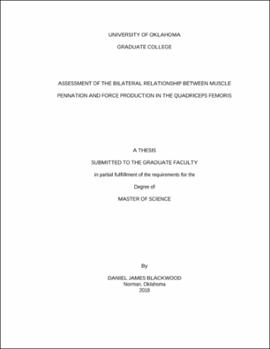| dc.description.abstract | Few studies have investigated the bilateral symmetry of pennation angle (PA). No research has examined the bilateral relationship between PA and force production (FP). Purpose: The purposes of this study were to: 1) determine the magnitude of asymmetry for PA and FP in the quadriceps femoris (QF) muscle group 2) determine if a correlation exists between PA and FP 3) determine if the correlation is symmetrical between limbs. Methods: Thirty-eight males age 19-32 were recruited to participate in this study. Twenty-five were resistance trained (RT) and 13 were non-resistance trained (NRT). All subjects performed the same tests during their visits and all measurements were made on both legs. The quadriceps femoris (QF) muscles were measured using B-mode ultrasound. Three screen captures were taken for each muscle: the vastus medialis (VM), vastus lateralis (VL), rectus femoris (RF) and vastus intermedius (VI). QF FP was measured on two separate visits by performing 3 knee extension maximal voluntary isometric contractions (MVICs). Lastly, leg composition was measured by DXA scan for lean mass, fat mass, and bone mineral content (BMC). For statistical analyses individuals’ legs were designated strong or weak legs based on FP. Results: No significant differences between groups for fat mass, BMC, or PA of any muscle (p > 0.05) was seen. The RT group had significantly higher lean mass in the strong (8378.3 ± 1577.2g vs. 7015.5 ± 1120.5g) and weak (8422.0 ± 1526.9g vs. 6898.5 ± 1171.5g) legs and significantly higher FP in the strong (1038.3 ± 235.0N vs. 782.3 ± 242.0N) and weak (950.6 ± 206.0N vs. 711.8 ± 235.4N) legs. The only significant difference found between legs when groups were combined was a higher FP in the strong leg (941.5 ±267.2N vs 878.1 ± 242.1). Only VI was correlated with FP (p = 0.035, r = 0.242). | en_US |
